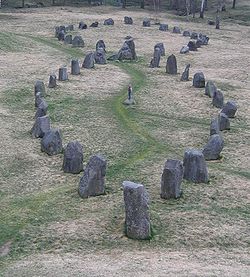Scholars agree that some elements of the funeral correspond to features of funerals distinctive to the North Germanic tribes, [17] particularly that it is a ship burial. However some features are not paralleled in Scandinavia at all, such as the use of basil, which is unlikely to have been available in Scandinavia, while some features are paralleled in Scandinavia, but are also paralleled more widely among the Turkic-speaking peoples among whom the events described by Ibn Fadlān took place, so they do not necessarily reflect Scandinavian culture. Thus, Ibn Fadlān's account is reminiscent of a detail in the Old Norse Völsa þáttr , where two pagan Norwegian men lift the lady of the household over a door frame to help her try to recover a sacred horse penis that has been thrown to her dog, [18] but other parallels exist among Turkic peoples.
Thus, some recent scholarship has sought to maximize the case that Ibn Fadlān informs us about practice in tenth-century Scandinavia, [20] [21] [22] while other work has tended to minimize it. [24]
Summary
Ibn Fadlan reports also what he observed for burials for those not of high status or wealth. He says that when a poor person dies, he is cremated in a small boat built by his fellows. When a slave dies, the dogs and carrion fowl devour the body. When a robber or thief dies, his body is hung on a tree and left there until the wind and rain dismember it. [25]
He then gives a detailed account of the burial he witnessed of a great man. In such a case, Ibn Fadlān says that a third of his wealth is inherited by his family, a third pays for the funeral clothes, and a third pays for nabīdh (an alcoholic drink) to be drunk at the cremation. [21]
The dead chieftain was put in a temporary grave with nābidh, fruit, and a drum, which was covered for ten days until they had sewn new clothes for him. Ibn Fadlān says that the dead man's family ask his slave girls and young slave boys for a volunteer to die with him; "usually, it is the slave girls who offer to die". A woman volunteered and was continually accompanied by two slave girls, daughters of the Angel of Death, being given a great amount of intoxicating drinks while she sang happily. When the time had arrived for cremation, they pulled his boat ashore from the river and put it on a platform of wood. [21]
They made a richly furnished bed for the dead chieftain on the ship. Thereafter, an old woman referred to as the "Angel of Death" put cushions on the bed. Then they disinterred the chieftain and dressed him in the new clothes. The chieftain was sat on his bed with nābidh, fruit, basil, bread, meat, and onions about him. [21]
Then they cut a dog in two and threw the halves into the boat, and placed the man's weapons beside him. They had two horses run themselves sweaty, cut them to pieces, and threw the meat into the ship. Finally, they killed two cows, a hen and a cock, and did the same with them. [21]
Meanwhile, the slave girl went from one tent to the other and had sexual intercourse with the master of each. Every man told her: "Tell your master that I have done this purely out of love for you." In the afternoon, they moved the slave girl to something that looked like a door frame, where she was lifted on the palms of the men three times. Every time, the girl told them what she saw. The first time, she saw her father and mother, the second time, she saw all her deceased relatives, and the third time she saw her master in Paradise. There, it was green and beautiful and together with him, she saw men and young people. She saw that her master beckoned for her. Then she was brought a chicken which she decapitated, and which was then thrown on the boat. [21]
Thereafter, the slave girl was taken away to the ship. She removed her bracelets and gave them to the old woman. Thereafter, she removed her anklets and gave them to the old woman's two daughters. Then they took her aboard the ship, but they did not allow her to enter the tent where the dead chieftain lay. The girl received several vessels of intoxicating drinks and she sang, before the old woman urged her to enter the tent. "I saw that the girl did not know what she was doing", notes Ibn Fadlān. [21]
Then the girl was pulled into the tent by the old woman and the men started to beat on their shields with sticks so her screams could not be heard. Six men entered the tent to have intercourse with the girl, after which they laid her onto her master's bed beside him. Two men grabbed her hands, and two men her wrists. The angel of death looped a rope around her neck and while two men pulled the rope, the old woman stabbed the girl between her ribs with a knife. [21]
Thereafter, the closest male relative of the dead chieftain walked backwards, naked, covering his anus with one hand and a piece of burning wood with the other, and set the ship aflame, after which other people added wood to the fire. An informant explained to Ibn Fadlān that the fire expedites the dead man's arrival in Paradise, by contrast with Islamic practices of inhumation. [21]
Afterwards, a round barrow was built over the ashes, and in the centre of the mound they erected a post of birch wood, where they carved the names of the dead chieftain and his king. Then they departed. [34]





